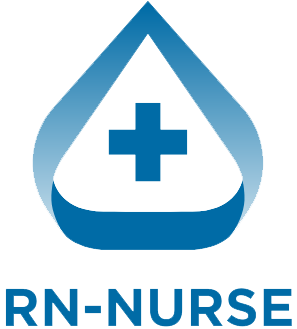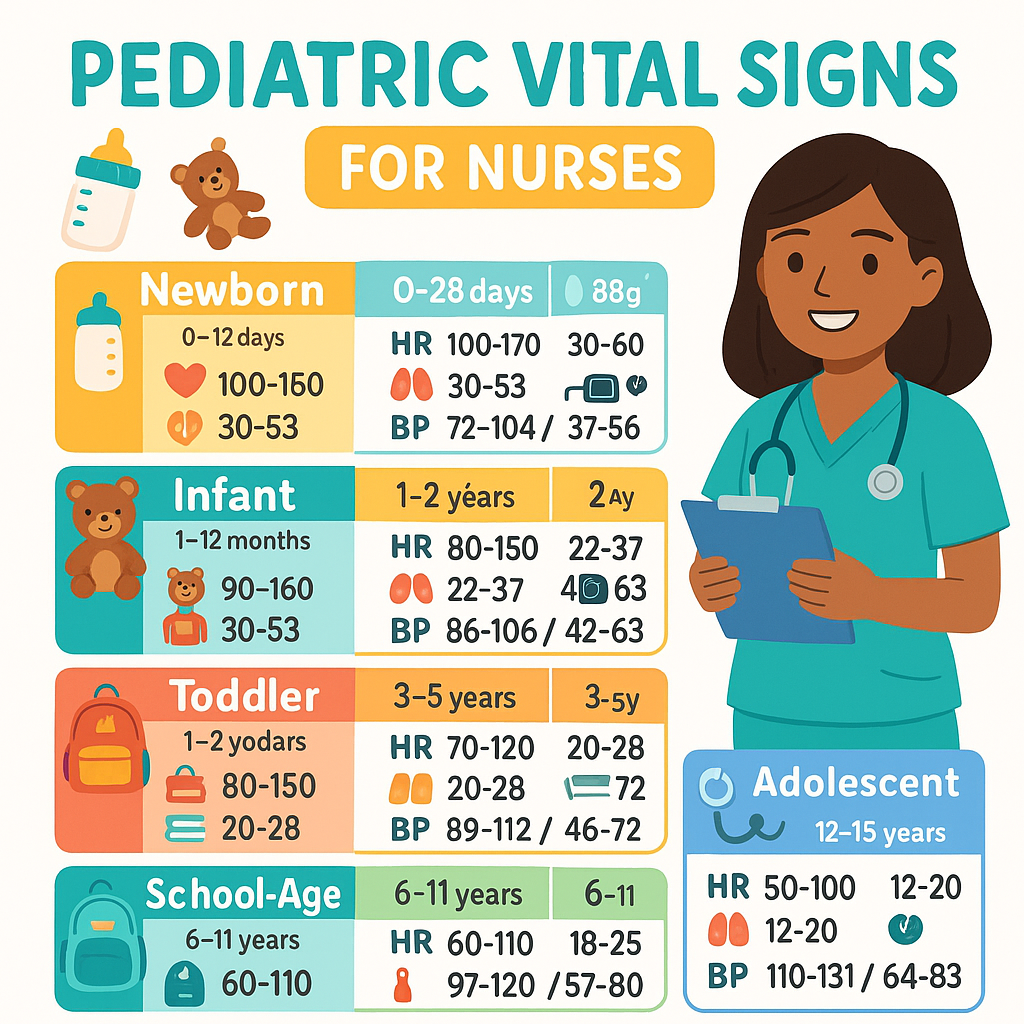Monitoring vital signs in children is a fundamental skill every nurse must master. Whether you’re preparing for the NCLEX, working in pediatrics, or reviewing a nursing bundle, understanding what’s normal for different age groups can help detect early signs of illness. This guide breaks down the normal ranges of vital signs from newborns to teenagers, making it simple for RN nurses, nursing students, and registered nurses alike.
✅ Why Pediatric Vital Signs Matter
Vital signs give quick insight into a child’s health. In pediatrics, what’s “normal” changes drastically with age. Heart rate, respiratory rate, blood pressure, and temperature vary widely between newborns and teens. Knowing these differences is crucial for effective nursing care.
👶 Newborn (0–28 days)
- Heart Rate: 100–160 bpm
- Respiratory Rate: 30–60 breaths/min
- Blood Pressure: 60–80/40–50 mmHg
- Temperature: 97.7–99.5°F (36.5–37.5°C)
💡 Nursing Tip: Newborns breathe irregularly with pauses—this is normal unless prolonged or associated with cyanosis.
🍼 Infant (1–12 months)
- Heart Rate: 100–160 bpm
- Respiratory Rate: 30–53 breaths/min
- Blood Pressure: 72–104/37–56 mmHg
- Temperature: 97.7–99.5°F
📝 NCLEX Alert: Fast breathing or low oxygen saturation can be early signs of distress in infants.
👦 Toddler (1–3 years)
- Heart Rate: 90–150 bpm
- Respiratory Rate: 22–37 breaths/min
- Blood Pressure: 86–106/42–63 mmHg
- Temperature: 98.6°F (37°C) average
🧠 Registered nurses must monitor toddlers closely during fever spikes, as febrile seizures are more common.
👧 Preschooler (3–5 years)
- Heart Rate: 80–140 bpm
- Respiratory Rate: 20–28 breaths/min
- Blood Pressure: 89–112/46–72 mmHg
🩺 Encourage deep breaths during assessments to get more accurate respiratory counts.
🎒 School-Age Child (6–12 years)
- Heart Rate: 75–118 bpm
- Respiratory Rate: 18–25 breaths/min
- Blood Pressure: 97–120/57–80 mmHg
📘 NCLEX tip: Blood pressure starts to resemble adult values at this stage. Start routine BP monitoring here.
👩🎓 Adolescent (13–18 years)
- Heart Rate: 60–100 bpm
- Respiratory Rate: 12–20 breaths/min
- Blood Pressure: 110–135/65–85 mmHg
🧍♀️ Adolescents often have adult-like vitals. Always assess vitals in context (activity level, anxiety, medications, etc.).
💉 Key Pediatric Vital Signs Chart for Nurses
| Age Group | HR (bpm) | RR (breaths/min) | BP (mmHg) | Temp (°F) |
|---|---|---|---|---|
| Newborn | 100–160 | 30–60 | 60–80 / 40–50 | 97.7–99.5 |
| Infant | 100–160 | 30–53 | 72–104 / 37–56 | 97.7–99.5 |
| Toddler | 90–150 | 22–37 | 86–106 / 42–63 | ~98.6 |
| Preschooler | 80–140 | 20–28 | 89–112 / 46–72 | ~98.6 |
| School Age | 75–118 | 18–25 | 97–120 / 57–80 | ~98.6 |
| Adolescent | 60–100 | 12–20 | 110–135 / 65–85 | ~98.6 |
🧠 Nursing Considerations for Pediatric Vitals
- Measure when calm: Crying or fear skews heart and respiratory rate.
- Always use age-appropriate equipment: Pediatric BP cuffs, infant stethoscopes, and soft thermometers.
- Trends matter: One abnormal value doesn’t always indicate a problem—watch for patterns over time.
- Know your norms: For the NCLEX, memorize pediatric vital signs ranges and know red flags.
🧪 Real-World RN Nurse Tips
- For accurate heart rate, auscultate the apical pulse for a full minute in infants.
- Respiratory rate is best counted before touching the child to avoid excitement.
- When taking BP, make sure the cuff is the correct size—too large or too small skews the reading.
- When charting, always document the child’s activity level during measurement (e.g., sleeping, crying, feeding).
🎓 Preparing for NCLEX with Pediatric Vitals
Every NCLEX exam will include questions on vital signs—especially pediatric ranges and what’s considered dangerous. A good nursing bundle should include cheat sheets or flashcards to help you learn:
- What’s a critical heart rate in an infant?
- What’s the first sign of deterioration in a pediatric patient?
- How do you prioritize care based on abnormal vital signs?
📌 Conclusion: Know Your Normals, Save a Life
Vital signs are a window into a child’s health—and as a nurse, recognizing what’s normal vs. alarming can save lives. Whether you’re a nursing student, a registered nurse, or studying for the NCLEX, this guide simplifies your learning and supports better clinical care.

